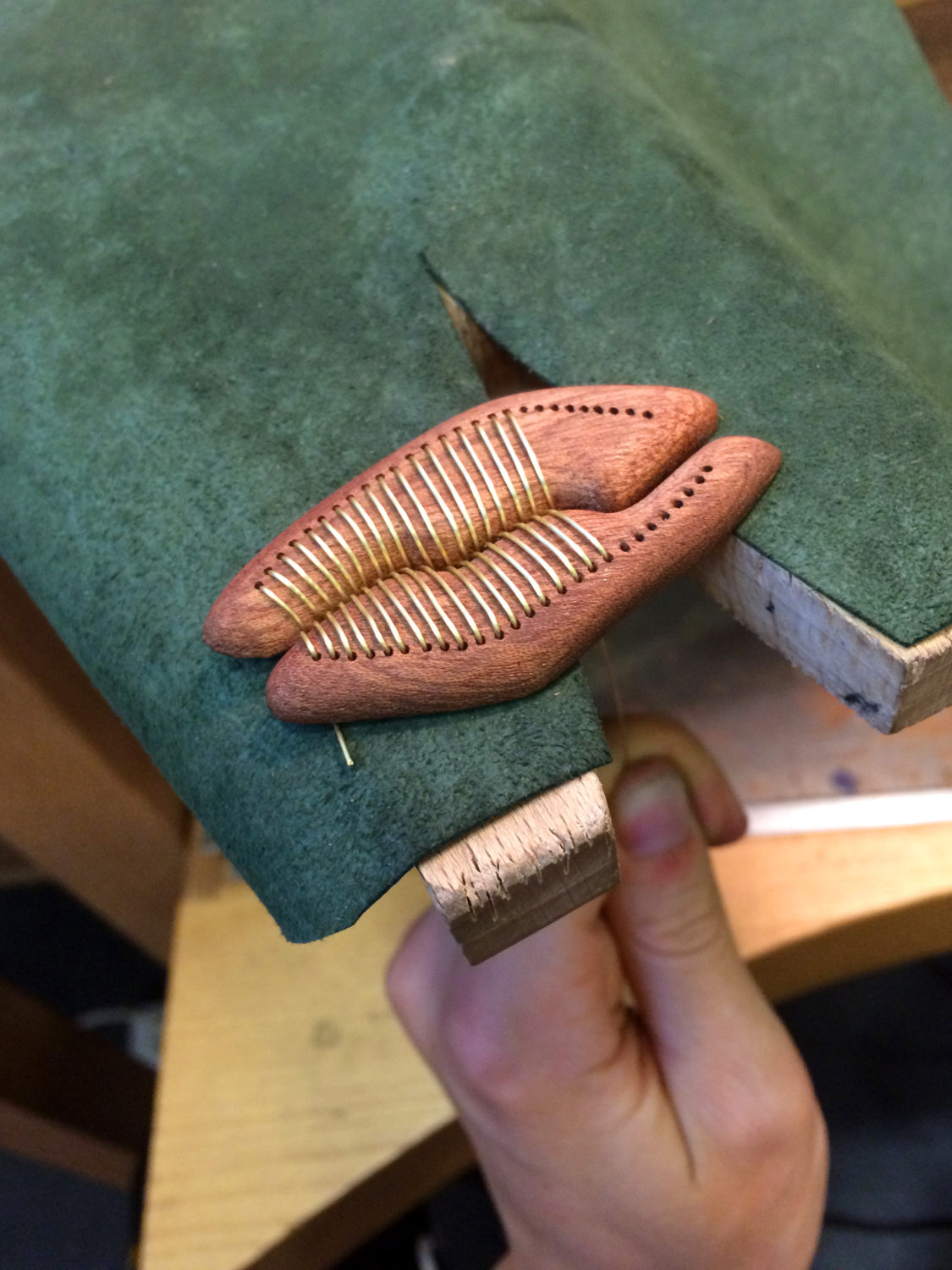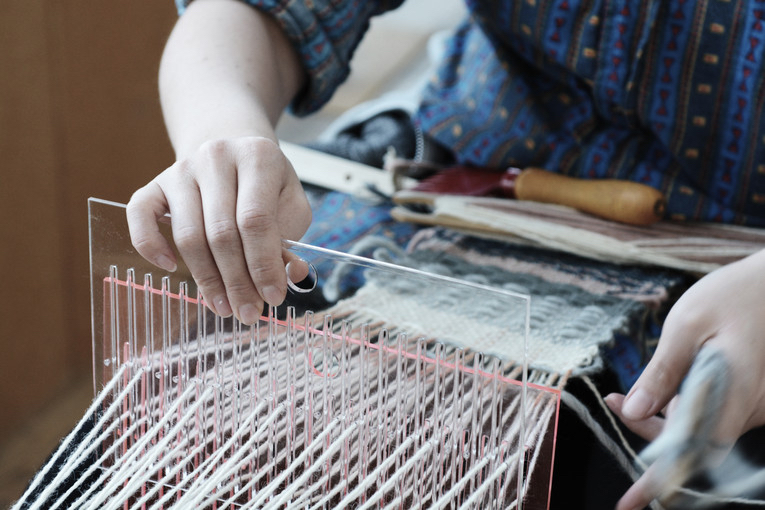‘We encourage the politicians and the leadership of Design School Kolding and the Royal Danish Academy to pause and reconsider what kind of education they wish to create.’
That was the conclusion to an opinion piece published on 2 April 2022 in the national newspaper Politiken.
The authors represented a group of students at Design School Kolding wishing to lend their support to the rebellion that had recently flared up among the students at the Royal Danish Academy in Copenhagen, where an exhibition opening for the exhibitors’ family and friends turned into a protest. The disturbance was soon tamped down by the academy’s leadership.
‘It was all very intense, and it got very emotional. It did not seem like a very pleasant situation for either side,’ says Iben Ramvad Kjær, a bachelor student in her second year of the Textile Design programme at Design School Kolding. She is also chair of the school’s Study Board. Together with Josefine My Sommer, a bachelor student in her second year of the Accessory Design programme and chair of the Student Council, she is sitting down with Formkraft for a conversation about the student rebellion in Danish design schools. Director of Education Eva Kappel, Design School Kolding, and Professor of Design History Anders V. Munch, University of Southern Denmark (SDU), are also present to offer their perspectives.
The rector’s open door
We meet in Rector Lene Tanggaard’s office at the school, even though she is not present herself. However, the room came to play an important role in a rebellion that could have turned into a major blaze but instead remained a small but significant spark, as it served as the setting for some of the talks that were held following the publication of the opinion piece in Politiken. Through these talks, the school’s leadership and students gradually found common ground. And that proved essential.
Necessary dialogue
Today the situation has changed significantly. The article resulted in much broader and more structured communication between the school’s leadership and its students, including conversations that focused on the students’ concerns. To some extent, these concerns still persist, but the dialogue has led to greater transparency and a better understanding of the critical issues.
‘Shortly after the publication of the opinion piece, we had some fruitful talks with the school’s leadership. Initially, this took place in a small forum involving the group that had authored the piece, the rector, the prorector and the director of education. Here, we had a chance to discuss our worries. It turned out much it had to do with understanding the basis of decisions such as allowing Quota 1 applications and making changes to our traineeships. Later, we continued the conversation in dialogue meetings in the canteen for all the students. This process has led to a high degree of transparency and allowed us to put out some brush fires,’ says Iben.
The most important challenge to address is concerns about the academization of design education.

Balancing theory and craft
‘As in Copenhagen, academization is a hot topic here,’ says Iben. ‘Generally speaking, the issue is that the education is implementing a very high theoretical level, and we need to ensure this does not happen at the cost of practice. If that happens, we could have just enrolled in Design Studies at SDU across the street,’ she says, with a nod to Professor Anders V. Munch, who is present during our talk. ‘Don’t get us wrong, we don’t want simply to design things without putting any thought into what we do. But there has to be a balance, and that appeared to be missing in Copenhagen. That was our concern.’
My Sommer adds, ‘We want to improve both our theoretical knowledge and our craft skills, and we want to understand the background for why we make the designs that we do. But we’re not all aiming to become professors, so it gives us pause when we hear talk of academization and when the school makes it a stated goal to have more PhD projects. That’s not why we’re here.’
Room for craft in the future?
For now, however, the two students agree that the balance between academic learning and hands-on practice in the workshop is pretty good. ‘We bring considerable academic insight with us into the workshop, where we are met by knowledgeable and competent teachers who help us translate it into practice,’ says My.
This does not mean that the debate about academization is over. ‘We note that the academic turn is happening very quickly in many other educational programmes that ought to be craft-based, so it’s definitely something we’re keeping an eye on. We want to be able to measure up to the best design schools around the world, but our learning should be conditioned by the craft aspect,’ says Iben.
The opportunity to engage in-depth with a craft is crucial to the two students.
‘You don’t arrive at the school with a fully-fledged identity as a designer. You might have been dabbling in something at home or at a folk high school. Once we arrive at the school, we discover that our dabbling or personal passion may rise to a level where it qualifies as professional design or perhaps decorative art, depending on the path each of us chooses,’ they point out.
They also aim to preserve a broad education system that recognizes book learning and craft skills equally. ‘I’m really worried that we might be headed for a future where children won’t, for example, learn woodworking skills in school. I worry that there might not be room for people who are gifted with good manual and creative skills. Many people are better at working with their hands, and design schools need to be able to embrace and support this,’ says My.
Artistic craft and design education
The conversation about developments in education also touches on the role of artistic craft in the design profession then and now, also in relation to the current rebellion. ‘It’s interesting to recall that the emphasis on craft and decorative arts was the 1970s version of a student rebellion against the prevailing emphasis on mass production and the consumer society,’ Anders V. Munch comments.
‘Today, I see our role more as designers than as makers or craft artist,’ says Iben, who can still relate to the social critique and their calls for change. ‘A key task for us is going to be the huge sustainability challenge that the world is facing today. That is really a personal passion for us. In this context, I guess we think of “craft” as an everyday hands-on practice rather the more artistic concept, where it is about making something pretty to be put in a display case and protected from finger marks.’
‘However, the design profession should be able to embrace all these different aspects. And we definitely feel super privileged to have the benefit of skilled and talented makers and craft artists as teachers. That’s also why we’re a little concerned to see that traineeships offered by specialists such as goldsmiths or shoemakers are becoming increasingly rare or perhaps disappearing altogether. After all, Denmark has a long-standing artistic craft tradition that has to be preserved and passed on,’ My adds.
Eva Kappel assures the students that it will still be possible to train for a career in decorative arts through the design programme, for example in the Textile or Accessories programmes. However, she also points out a connection between artistic craft and academization.
‘Artistic craft as a discipline still has its justification at the school today but not necessarily with the production of decorative art objects as its only goal. Where it gets really interesting is where decorative arts become an in-depth exploration of forms, techniques and material experiments that approaches research. When that happens, artistic craft can help move design practices into new positions,’ she argues.

Excellent workshop facilities
The two students feel that the necessary discussion about the concept and degree of academization is in good shape today. The issue of reduced workshop access that was such a key topic in Copenhagen does not present a major challenge in Kolding.
‘Almost on the contrary,’ says Iben. ‘Until recently, our workshops were open round the clock; in fact, we had so much workshop access that we were almost tempted to bite off more than we can chew,’ she says. ‘However, many of us chose Kolding precisely because the school offers so many workshop facilities.’
Currently, however, the workshops are closed from midnight to six in the morning as part of the school’s energy-saving measures. That might actually be a good thing, says My: ‘Maybe this is where we, as the Student Council, should encourage our fellow students to take some time off every now and then.’
The dialogue continues
If Iben and My were to offer their fellow students in Copenhagen a piece of advice it would be to make sure, above all, to establish good communication routines with the school’s leadership and to maintain and prioritize student participation in the school’s governing bodies.
‘We were able to wrap some issues up fairly quickly because they stemmed mainly from a lack of transparency in decision-making. For example, it was a general perception that the traineeships had been cancelled. However, it soon became clear that they had been moved to the master’s level in order to enable as much workshop time as possible in the bachelor’s programme to ensure sufficient practical experience to take on a job,’ Iben explains.
‘However, there are other issues that we will continue to debate in the future,’ says My, ‘including the issue of students’ well-being in the creative universe. Creative professionals are often sensitive souls who find themselves in a competitive profession where everyone is always comparing themselves to others. Well-being is crucial in this type of school, and it doesn’t take much before a sense of apprehension emerges in such a relatively small environment.’
Theme: Student Rebellion
Formkraft gives the floor to both students and institutions and examines contemporary educational opportunities for craft artists and designers.
Follow along from November 2022 – January 2023 when Formkraft takes stock of the design education in Denmark. Read theme


